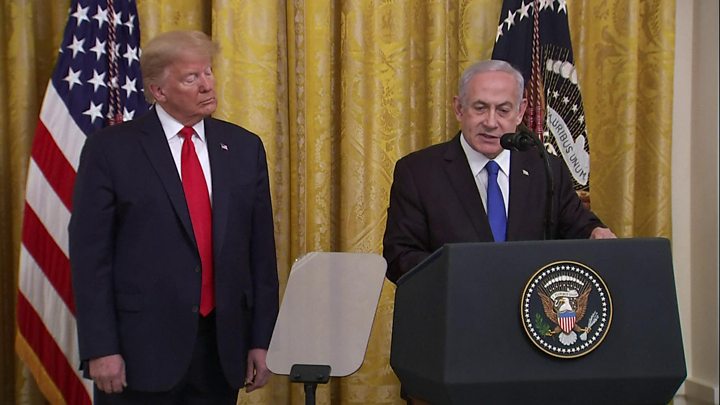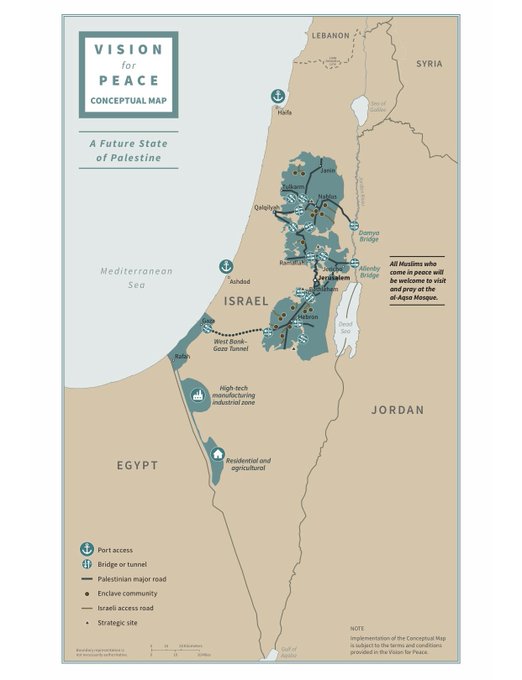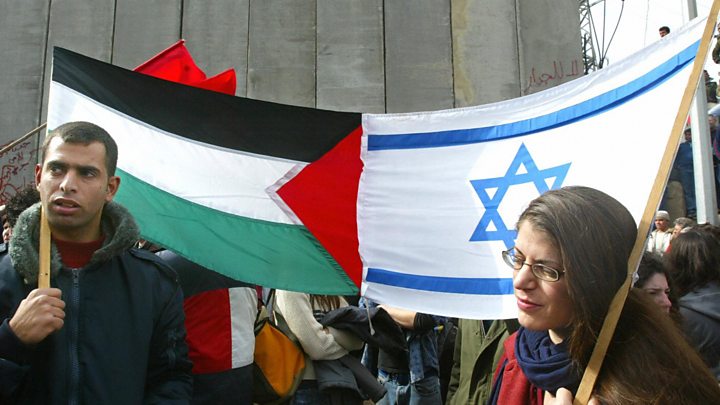Palestinians have dismissed US President Donald Trump’s new Middle East peace plan as a “conspiracy”.
The plan envisages a Palestinian state and the recognition of Israeli sovereignty over West Bank settlements.
Jerusalem will remain Israel’s “undivided” capital, but the Palestinian capital will “include areas of East Jerusalem”.
Reacting to Tuesday’s announcement, Palestinian President Mahmoud Abbas said: “Jerusalem is not for sale”.
“All our rights are not for sale and are not for bargain,” he added.
Thousands of Palestinians held protests in the Gaza Strip, while the Israeli military deployed reinforcements in the occupied West Bank.
The blueprint, which aims to solve one of the world’s longest-running conflicts, was drafted under the stewardship of President Trump’s son-in-law Jared Kushner.
Standing alongside Israeli PM Benjamin Netanyahu at the White House on Tuesday, Mr Trump said his proposals “could be the last opportunity” for Palestinians.

Meanwhile, reports said Mr Netanyahu was planning to press ahead with annexing 30% of the occupied West Bank, with a cabinet vote due on Sunday.
Israel has settled about 400,000 Jews in West Bank settlements, with another 200,000 living in East Jerusalem. The settlements are considered illegal under international law, although Israel disputes this.

What did Mr Abbas say?
Speaking on Tuesday, he said it was “impossible for any Palestinian, Arab, Muslim or Christian child to accept” a Palestinian state without Jerusalem as its capital.
“We say a thousand times, no, no, no,” he said. “We rejected this deal from the start and our stance was correct.”
The militant Palestinian Islamist group Hamas, which controls the Gaza Strip, also rejected the deal which it said aimed “to liquidate the Palestinian national project”.
The UN said it remained committed to a two-state solution based on the borders in place before the 1967 war, when Israel seized the West Bank and Gaza.
How about international reactions?
A spokesman for UN Secretary General António Guterres called for a peace deal on the basis of UN resolutions, international law and bilateral agreements.

The Arab League said it would hold an urgent meeting on Saturday.
British Foreign Secretary Dominic Raab urged the Palestinians to give the plans “genuine and fair consideration and explore whether they might prove a first step on the road back to negotiations”.
What are Trump’s key proposals?
“Today, Israel takes a big step towards peace,” Mr Trump said at the White House on Tuesday.
“My vision presents a win-win opportunity for both sides, a realistic two-state solution that resolves the risk of Palestinian statehood to Israel’s security.”
His proposals are:
- The US will recognise Israeli sovereignty over territory that Mr Trump’s plan envisages being part of Israel. The plan includes a conceptual map that Mr Trump says illustrates the territorial compromises that Israel is willing to make
- The map will “more than double the Palestinian territory and provide a Palestinian capital in eastern Jerusalem”, where Mr Trump says the US would open an embassy. The Palestine Liberation Organisation (PLO) said Mr Trump’s plan would give Palestinians control over 15% of what it called “historic Palestine”.
- Jerusalem “will remain Israel’s undivided capital”. Both Israel and the Palestinians hold competing claims to the holy city. The Palestinians insist that East Jerusalem, which Israel occupied in the 1967 Middle East war, be the capital of their future state.
- An opportunity for Palestinians to “achieve an independent state of their very own” – however, he gave few details.
- “No Palestinians or Israelis will be uprooted from their homes” – suggesting that existing Jewish settlements in the Israeli-occupied West Bank will remain.
- Israel will work with the king of Jordan to ensure that the status quo governing the key holy site in Jerusalem known to Jews as the Temple Mount and al-Haram al-Sharif to Muslims is preserved. Jordan runs the religious trust that administers the site.
- Territory allocated to Palestinians in Mr Trump’s map “will remain open and undeveloped for a period of four years”. During that time, Palestinians can study the deal, negotiate with Israel, and “achieve the criteria for statehood”.
“Palestinians are in poverty and violence, exploited by those seeking to use them as pawns to advance terrorism and extremism. They deserve a far better life,” Mr Trump said.Skip Twitter post by @realDonaldTrump

Donald J. Trump✔@realDonaldTrumpReplying to @realDonaldTrump
This is what a future State of Palestine can look like, with a capital in parts of East Jerusalem.

25.4K6:26 AM – Jan 28, 2020Twitter Ads info and privacy16.1K people are talking about thisReport
End of Twitter post by @realDonaldTrump
- Can the Jewish settlement issue be resolved?
- Are there alternatives to a two-state solution?
- What makes Jerusalem so holy?
He also indicated that the West Bank would not be cut in half under the plan.
“We will also work to create a contiguous territory within the future Palestinian state, for when the conditions for statehood are met, including the firm rejection of terrorism,” he said.
Israeli officials said Mr Netanyahu would fly to Moscow on Wednesday to discuss the proposals with Russian President Vladimir Putin.

A plan that overturns Palestinian aspirations

Until now all of the most difficult aspects of an Israeli-Palestinian peace deal – the so-called final status issues – like borders; the future of Israeli settlements in the West Bank; the long-term status of Jerusalem; and the fate of Palestinian refugees, were to be left for face-to-face talks between the Israelis and Palestinians themselves.
Not any longer. The deal proposed by President Trump and enthusiastically endorsed by Prime Minister Netanyahu essentially frames all of these issues in Israel’s favour.
The Palestinians were not just absent from this meeting – they have boycotted the Trump administration ever since it unilaterally moved its embassy to Jerusalem. But they have essentially been presented with an ultimatum – accept the Trump parameters or else, and they have been given some four years to come around.
While President Trump is offering the Palestinians a state it would be a much truncated one. No Jewish settlers will be uprooted and Israeli sovereignty will apparently be extended to the settlement blocs and the Jordan Valley. The Palestinians might have a capital in the East Jerusalem suburbs. This “take it or leave it offer” will appal many long-standing students of the region. The question now is not so much what benefit this deal might bring but how much damage it may do by over-turning Palestinian aspirations.

What’s the background?

The Palestinians broke off contacts with the Trump administration in December 2017, after Mr Trump decided to recognise Jerusalem as Israel’s capital and move the US embassy to the city from Tel Aviv.
Since then, the US has ended both bilateral aid for Palestinians and contributions for the UN Relief and Works Agency for Palestine Refugees (UNRWA).
And in November, Secretary of State Mike Pompeo said the US had abandoned its four-decades-old position that Jewish settlements in the West Bank were inconsistent with international law.

What are the issues at stake?
Of all the conflicts in the Middle East, that between Israel and the Palestinians has been the most intractable. Although the two sides signed a breakthrough peace accord in 1993, more than a quarter of a century on the two sides are arguably as far apart as ever.
Jerusalem: Both Israel and the Palestinians hold competing claims to the city. Israel, which occupied the formerly Jordanian-held eastern part in 1967, regards the whole of Jerusalem as its capital. The Palestinians insist on East Jerusalem – home to about 350,000 of their community – as the capital of a hoped-for independent state.
Palestinian statehood: The Palestinians want an independent state of their own, comprising the West Bank, Gaza and East Jerusalem. Israeli prime ministers have publicly accepted the notion of a Palestinian state alongside Israel but not what form it should take. Benjamin Netanyahu has said any Palestinian state should be demilitarised with the powers to govern itself but not to threaten Israel.
Recognition: Israel insists that any peace deal must include Palestinian recognition of it as the “nation-state of the Jewish people”, arguing that without this Palestinians will continue to press their own national claims to the land, causing the conflict to endure. The Palestinians says what Israel calls itself is its own business, but to recognise it as the Jewish state will discriminate against Israel’s Arab population of Palestinian origin, who are Muslims, Christians and Druze.
Borders: Both sides have fundamentally different ideas as to where the boundaries of a potential Palestinian state should be. The Palestinians insist on borders based on ceasefire lines which separated Israel and East Jerusalem, the West Bank and Gaza between 1949 and 1967. Israel says those lines are militarily indefensible and were never intended to be permanent. It has not said where borders should be, other than making clear its own eastern border should be along the Jordan River.
Settlements: Since 1967, Israel has built about 140 settlements in the occupied West Bank and East Jerusalem, as well as 121 outposts – settlements built without the government’s authorisation. They have become home to some 600,000 Israeli Jews. Settlements are considered illegal by most of the international community, though Israel disputes this. Palestinians say all settlements must be removed for a Palestinian state to be viable. Mr Netanyahu has vowed not only to never to uproot any settlements but to bring them under Israeli sovereignty.
Refugees: The UN says its agencies support about 5.5 million Palestinian refugees in the Middle East (the Palestinian Authority says there are up to 6 million), including the descendants of people who fled or were expelled by Jewish forces from what became Israel in the 1948-49 war. Palestinians insist on their right to return to their former homes, but Israel says they are not entitled to, noting that such a move would overwhelm it demographically and lead to its end as a Jewish state.

100 years of Israeli-Palestinian conflict: Key moments*
- Nov 2019: Trump administration says it no longer considers Israeli settlements in occupied territory as inconsistent with international law, putting the US at odds with most of international community
- Dec 2017: Donald Trump announces US recognition of Jerusalem as Israel’s capital – Palestinians cut off relations with Trump administration
- April 2014: Last round of direct Israel-Palestinian peace talks collapse amid acrimony
- Sept 2000- Feb 2005: Second Palestinian uprising
- Sept 1993: Israel-Palestinians sign Oslo peace accords, agreeing framework for eventual peace deal; 20 years of on-off peace talks – and violence – follow
- Dec 1987-Sept 1993: First Palestinian uprising against Israeli occupation
- June 1967: Middle East war – Israel occupies East Jerusalem, West Bank and Gaza Strip; years of hostility and bloodshed follow; UN Security Council Resolution 242 calls on Israel to withdraw from “territories occupied in recent conflict” and recognises the right of “every state in the area to live in peace within secure and recognised boundaries”
- May 1948: British Mandate for Palestine terminates; Israeli statehood declared, Arab countries invade, conflict creates 700,000 Palestinian refugees; 800,000 Jews expelled or flee from Arab countries in wake
- Nov 1947: UN recommends partitioning Mandate Palestine into Jewish and Arab states – Jewish leadership in Palestine accept, Arab leadership reject; violence between two sides escalates
- July 1922: League of Nations entrusts Britain as Mandatory power to put terms of Balfour Declaration into effect
- Dec 1917: British forces conquer and occupy Palestine; in years that follow, violence between Jews and Arabs increases
- Nov 1917: Britain (fighting Ottoman Empire in WWI) issues “Balfour Declaration” expressing support for Jewish “national home” in Palestine on condition that the rights of non-Jewish communities there are not prejudiced
- Pre-1917: Turkish Ottoman Empire rules over Jewish and Arab communities in geographical area referred to as Palestine, the Holy Land or (by Jews) the Land of Israel
* entries are selective and abridged
bbc